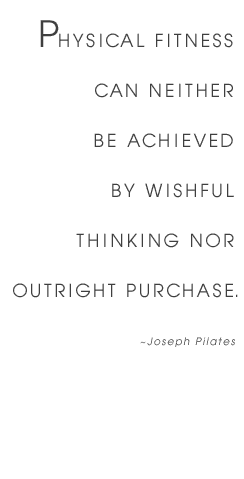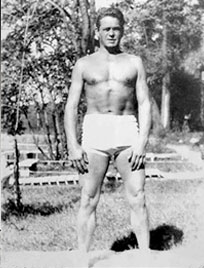


 Joseph H. Pilates was born in Germany in 1883. His father was a prize-winning gymnast and his mother worked as a naturopath. He was a man who believed completely in his method and practiced what he prescribed to others well into his eighties. Even as an older man Pilates was quite robust and vital until his death, in 1967, at the age of 83.
Joseph H. Pilates was born in Germany in 1883. His father was a prize-winning gymnast and his mother worked as a naturopath. He was a man who believed completely in his method and practiced what he prescribed to others well into his eighties. Even as an older man Pilates was quite robust and vital until his death, in 1967, at the age of 83.
Unhealthy as a child, Pilates suffered from rickets, asthma, and rheumatic fever. He studied many different systems in an effort to restore his own health. From the Eastern disciplines, he studied yoga and martial arts, from Western disciplines gymnastics, bodybuilding, and boxing, and he drew on the ancient Greek ideal of perfecting the development of mind, body, and spirit. From his studies Joseph believed that bad posture, inefficient breathing, and lifestyle were the root of poor health. At an early age he dedicated his life to improving his physical as well as mental strength and became a body builder, diver, and gymnast.
In 1912 he moved to England where he became a professional boxer and taught self-defense at police schools and Scotland Yard. When Britain entered WWI, his German citizenship led to his imprisonment along with other German nationals as “enemy aliens” on the Isle of Man. This was a fundamental time in the intensive development of the Pilates method as an integrated, comprehensive fitness program. He began the floor exercises that evolved in to what we now know as Pilates Mat work. He also began rehabilitating detainees suffering from injuries utilizing items available to him such as beds, bedsprings, and beer keg rings to create resistance exercise equipment. This can be seen in today’s version of the Cadillac and Magic Circle. Proof of the relationship of good fitness and health is the 1918 influenza epidemic. It is said that the excellent physical condition of Pilates and his fellow detainees was the reason all survived, while populations in other internment camps and across the world were decimated.
In 1925, Pilates emigrated to America. While on a boat headed to NYC he met his wife Clara, a nurse. They were married, settled in NYC, and together founded a studio.
Clara helped Pilates in the evolution and development of his program. They worked on the methodology, designed the equipment, and trained students. Pilates was originally called Contrology as it was a process of using the mind to control the muscles of the body. The main focus being the core muscles of the body, also known as postural muscles, which help give the spine its support. In addition to strengthening the deep core muscles, focus was placed on the awareness of breath and body alignment. Although the name Contrology didn’t stick, the method did and continued on as Pilates.
Pilates’ New York studio (1926-1966) was in close proximity to many dance facilities and quickly became sought after by the likes of George Balanchine and Martha Graham. Dancers and elite athletes would come regularly to improve strength, maintain flexibility, and take advantage of the rehabilitative techniques Pilates had to offer. It was in the 1980’s that a surge of interest began to take the benefits of Pilates mainstream. With the help of the elders, a committed group of first generation teachers, it was made possible for the original work and intent of Pilates to stay alive. Other students have gone on to incorporate this method in to anatomy and movement sciences increasing its use in both physical therapy and rehabilitation.






